THANK YOU!
YOUR PURCHASE OF THESE BOOKS SUPPORTS THE WEB SITES THAT BRING TO YOU THE HISTORY BEHIND OLD AIRFIELD REGISTERS
Your copy of the Davis-Monthan Airfield Register with all the pilots' signatures and helpful cross-references to pilots and their aircraft is available at the link. 375 pages with black & white photographs and extensive tables
---o0o---
The Congress of Ghosts (available as eBook) is an anniversary celebration for 2010. It is an historical biography, that celebrates the 5th year online of www.dmairfield.org and the 10th year of effort on the project dedicated to analyze and exhibit the history embodied in the Register of the Davis-Monthan Airfield, Tucson, AZ. This book includes over thirty people, aircraft and events that swirled through Tucson between 1925 and 1936. It includes across 277 pages previously unpublished photographs and texts, and facsimiles of personal letters, diaries and military orders. Order your copy at the link.
---o0o---
Military Aircraft of the Davis Monthan Register, 1925-1936 is available at the link. This book describes and illustrates with black & white photographs the majority of military aircraft that landed at the Davis-Monthan Airfield between 1925 and 1936. The book includes biographies of some of the pilots who flew the aircraft to Tucson as well as extensive listings of all the pilots and airplanes. Use this FORM to order a copy signed by the author, while supplies last.
---o0o---
Art Goebel's Own Story by Art Goebel (edited by G.W. Hyatt) is written in language that expands for us his life as a Golden Age aviation entrepreneur, who used his aviation exploits to build a business around his passion. Available as a free download at the link.
---o0o---
Winners' Viewpoints: The Great 1927 Trans-Pacific Dole Race (available as eBook) is available at the link. This book describes and illustrates with black & white photographs the majority of military aircraft that landed at the Davis-Monthan Airfield between 1925 and 1936. The book includes biographies of some of the pilots who flew the aircraft to Tucson as well as extensive listings of all the pilots and airplanes. Use this FORM to order a copy signed by the author, while supplies last.
---o0o---
Clover Field: The first Century of Aviation in the Golden State (available in paperback) With the 100th anniversary in 2017 of the use of Clover Field as a place to land aircraft in Santa Monica, this book celebrates that use by exploring some of the people and aircraft that made the airport great. 281 pages, black & white photographs.
---o0o---
YOU CAN HELP
I'm looking for information and photographs of this airplane to include on this page. If you have some you'd like to share, please click this FORM to contact me.
---o0o---
SPONSORED LINKS
PLEASE HELP KEEP THESE WEB SITES ONLINE
FOR YOUR CONVENIENCE
You may NOW donate via PAYPAL by clicking the "Donate" icon below and using your credit card. You may use your card or your PAYPAL account. You are not required to have a PAYPAL account to donate.
Or you can scan the QR code below with your mobile device and be linked to your PayPal app.
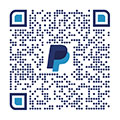 |
|---|
Either way, when your donation clears the PAYPAL system, a certified receipt from Delta Mike Airfield, Inc. will be emailed to you for your tax purposes.
---o0o---
ZENSAKU AZUMA
Zensaku Azuma was born on September 25, 1893 at Ishikawaken, Japan. He came to the U.S. in 1916. A short while later, at age 24, he completed a WWI draft registration card on June 5, 1917, below. His occupation was listed as a "Farm Hand." One news article from 1931 stated that he was an enlisted man in the army, but I don't know if he served in Europe. Other articles stated that he was a mechanic and learned to fly in the Army Air Service during WWI. If you know anything more about his service record, please let me KNOW.
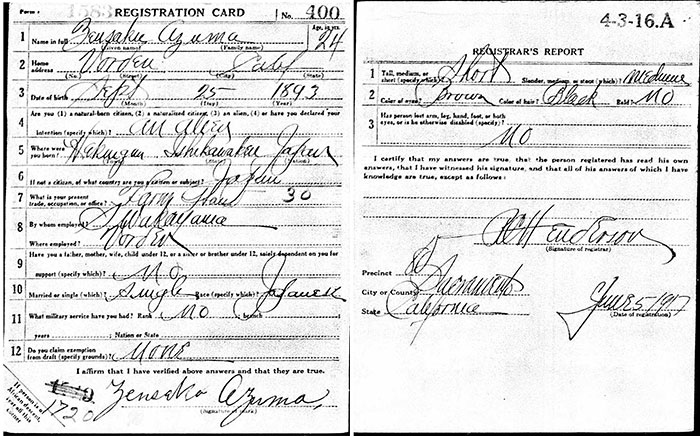 |
As with many things, the details are in the fine print. If you look carefully at the diagonal printing at the lower left of this card, the text says, "If person is of African descent, tear off this corner." This example of organized racism by the government did not extend to Asians, yet. That would occur some twenty-five years later during WWII with the forced relocation and incarceration in camps in the interior of the country of United States citizens of Japanese descent.
Zensaku Azuma's name was spelled two ways in various sources: Zensaku and Jensaku. He signed the Clover Field Register as "J.H. Azuma," but he signed the Oxnard Field Register as Zensaku (I have a copy of the Oxnard Register, 1927-1942, from Albuquerque, NM, but I have developed no Web site for it yet). The handwriting in both Registers matches.
Azuma (1893-1967) had an early effect on another Register pilot Henry Ohye. Azuma gave Ohye his first airplane ride at age 17 during the summer of 1927. Azuma was at the controls of hiss Hisso-powered Curtiss JN-4 ("Jenny;" registration number unknown). The ride lasted 15 minutes before engine problems cut it short. But it was enough to encourage Ohye to learn to fly. Please direct your browser to Ohye's Web page for further details about his life.
The 1920 U.S. Census, which would have been his first (name spelled Jensaku), placed him living as a boarder with a Japanese family in Princeton, CA north of Sacramento. He was single, age 27, and coded as an alien. His occupation was identified as an "Engineer" for a "Gas Engine" (sic).
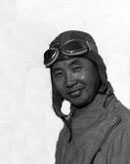 |
Azuma landed and signed the Santa Monica Register once, on Friday, April 11, 1930 at 1:00PM. He was solo in the Waco GXE he identified as NC4574. The airplane belonged to Bob Lloyd. He arrived at Santa Monica from what he identified as the "No. Hollywood Airport." There was a Bob Lloyd Field in North Hollywood, so this might be where he flew in from. He cited no destination that day.
Azuma's main claim to fame was a flight made a couple of months later in 1930. At right, his portrait is from a German Web page that celebrates a round-the-world solo flight made by Azuma in 1930 (see below). Please direct your browser there to see a map of his flight. There are several sites across the Web that contain much the same information as the one at the link.
 |
Likewise, there were many news articles printed in papers worldwide that covered his flight before, during and after its completion. One example, below, is from a Pennsylvania paper that appeared about two months after his visit at Santa Monica, just before he departed.
.jpg) |
Indeed, about two months after he visited us at Santa Monica, Azuma flew from Los Angeles to New York. Coincidentally, his flight across the U.S. was the first for a Japanese. The airplane he flew was the Travel Air NC/NR4835. Please direct your browser to his airplane's link for further information about his voyage, and about his personality. Another good source for Azuma and NR4835 is at the link.
He had his airplane disassembled in New York and loaded on a ship. According to ancestry.com records, he and NR4835 made the voyage to England from New York aboard the S.S. Olympic, landing at Southampton on July 16, 1930. His occupation was cited as "Aviator." The purpose of his voyage was captured in Popular Aviation (PA) magazine, September, 1931, above. Yes, he operated a Chinese restaurant as a Japanese. I've read mixed reports as to the status of his restaurant while he was going around the world. One news article reported that he sold the operation; another said he left it open under the management of his wife.
His restaurant was not a storefront hole in the wall or just a "chop suey" restaurant as cited in many period newspapers. A vintage photograph of his Hollywood Oriental Cafe on Fair Oaks Avenue in Pasadena, CA is below from the link.
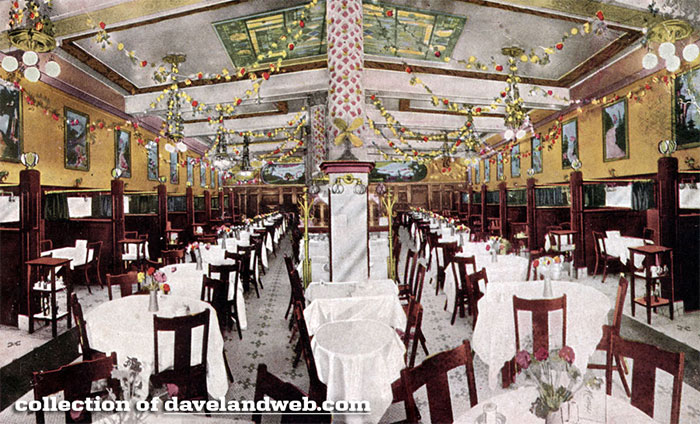 |
But I digress. After flying across the United States, then traveling by ship to England, his disassembled Travel Air was reassembled in England. He departed England for parts east on July 27th. His itinerary was charted at the German language link, above. Azuma flew an aggressive itinerary eastbound across Europe and Asia, finally to his home country. He landed in Tokyo August 31, 1930. The Albuquerque Journal (NM) reported his arrival in Japan, below.
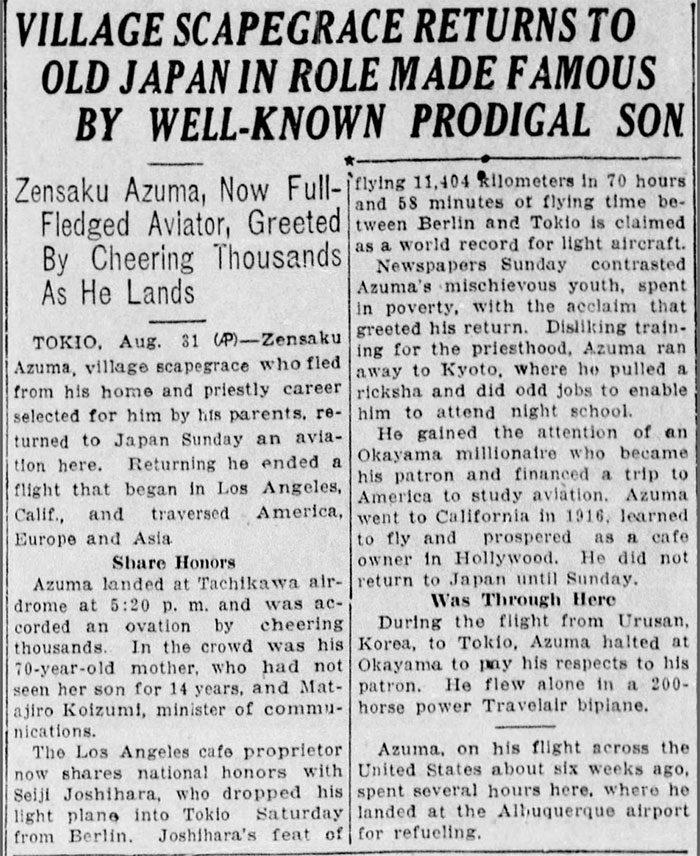 |
Note mention of his landing at Oxnard Field in Albuquerque during his initial flight across the U.S.
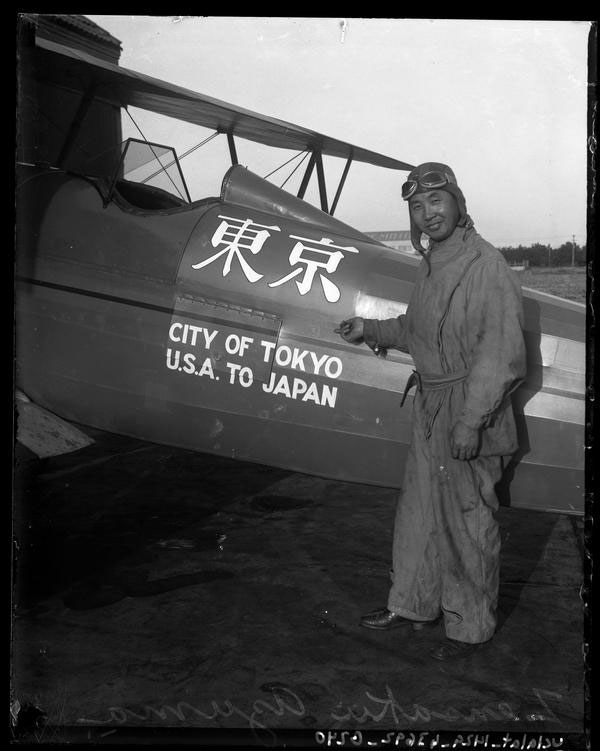 |
Photograph, right from the Los Angeles Times Photographs Collection, shows Azuma with NR4835. The exact date and location were not identified. Compare his portrait above with his profile in this view. It appears someone "PhotoShopped" him out of this image.
Azuma made a couple of trips back and forth to Japan by ship. After his long-distance flight he remained in Japan for a few months. He returned from Yokohama to the U.S. aboard the M.S. Tatsuta Maru on January 9, 1931. His departure was fêted by a U.S. Navy airplane that circled the Tatsuta Maru as it left the Yokohama harbor. Upon his return to Pasadena, several newspapers reported that a silver crown was placed upon his head by admirers and he was treated to a banquet.
His airplane remained in Japan, however, and wound up in the hands of the Japanese army. The military had no use for it and sold into the corporate world. It was registered J-BAOJ and flown as a news courier in Japanese-occupied China and the Korean peninsula. It crashed near Pusan ca. 1932 and was not repaired.
On January 23, 1931, a filler article appeared in the Stanford Daily (CA) of January 23, 1931 that hinted of a one-stop trans-Pacific flight by Azuma from California to Japan, if he could raise the money. The same article appeared in several newspapers across the country. He did not raise the money, the flight did not happen, and his appearance in the newspapers stopped cold after about June 1932.
At some point he returned to Japan (not by airplane), because eighteen months later, he sailed aboard the Taiyo Maru of Japanese registry, to a landing at San Pedro, CA on June 30, 1932. I do not know the purpose for this trip, except through an obscure reference in one news article that said he went to Japan to begin an air transport company there, and that he was unsuccessful at doing so. This sea voyage might have been that trip.
At some point, probably after WWII ended, Azuma returned to Japan permanently and became a post-WWII advocate for nuclear power. He discovered uranium deposits in Japan. Furthermore, he touted its health benefits and grew and consumed vegetables from soil containing uranium.The Japan Times of July 17, 2011 reported on the history of nuclear energy use in Japan after the 2011 tsunami that compromised the Fukushima Daiichi Nuclear Power Station. Azuma was featured in the article, and was called, "...'Japan's Charles Lindbergh,' a flamboyant pilot who encouraged people to search for uranium in their backyards."
---o0o---
SPONSORED LINKS
THIS PAGE UPLOADED: 09/27/16 REVISED:
